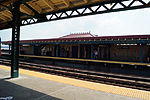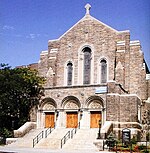Messiah Mission Church (New York City)
1916 establishments in New York CityChristian organizations established in 1916Churches completed in 1927Churches in ManhattanFormer Lutheran churches in the United States ... and 2 more
Inwood, ManhattanLutheran churches in New York City
Messiah Mission Church, also known as Messiah Evangelical Lutheran Church, was a Lutheran church in the Inwood neighborhood of Manhattan. The congregation was founded in 1916 and a two-storey brick school and chapel was built 1926 to designs by George W. Conable 46 West 24th Street, at 198-200 Sherman Avenue. The pastor who built the 1926 school church was Frederick P. Wilhem of 609 West 204th Street.Messiah merged in 1945 with St. Matthew's Lutheran Church with that congregation moving into Messiah's building. Messiah's church was sold when St. Matthew's (with Messiah) moved into a newly built church at 202 Sherman Avenue, Inwood, in 1957.
Excerpt from the Wikipedia article Messiah Mission Church (New York City) (License: CC BY-SA 3.0, Authors).Messiah Mission Church (New York City)
West 204th Street, New York Manhattan
Geographical coordinates (GPS) Address Nearby Places Show on map
Geographical coordinates (GPS)
| Latitude | Longitude |
|---|---|
| N 40.86554 ° | E -73.92173 ° |
Address
West 204th Street 611
10034 New York, Manhattan
New York, United States
Open on Google Maps









